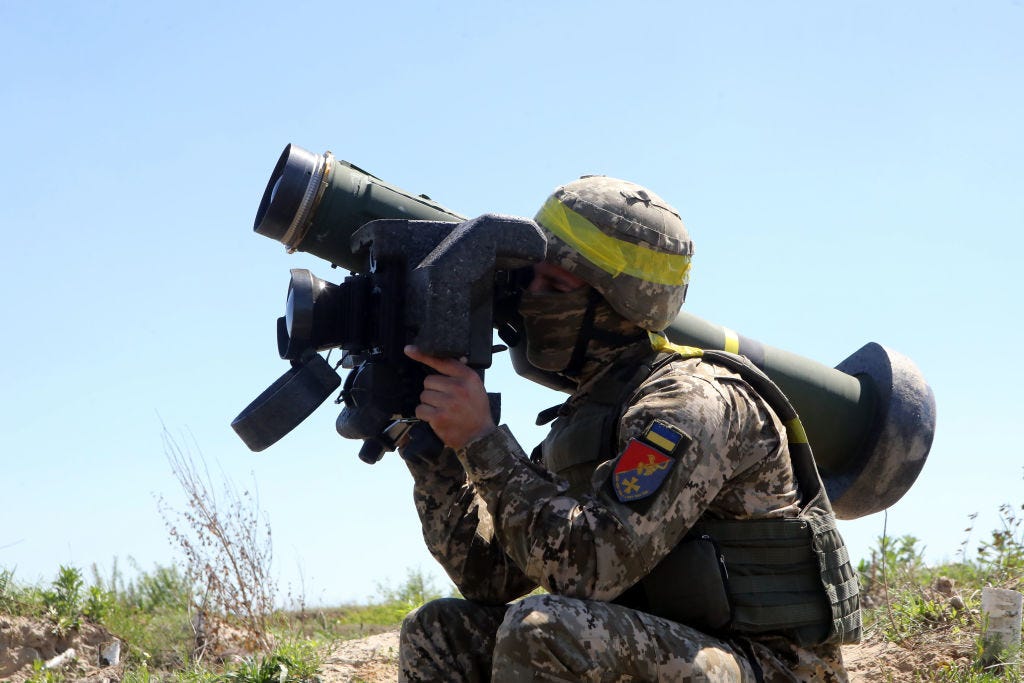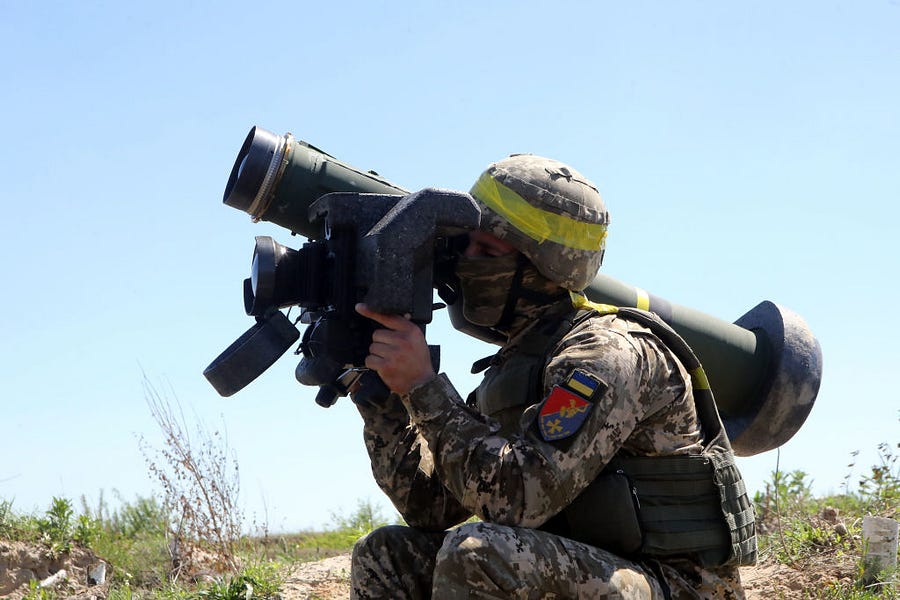Happy Wednesday! Neither of your Morning Dispatchers were alive when the Berlin Wall fell, but we’re feeling old this morning: Apple announced yesterday that, after more than 20 years, it is discontinuing the iPod.
Quick Hits: Today’s Top Stories
-
The average price of regular gasoline in the United States hit a record-high $4.37 per gallon yesterday, according to AAA data. President Joe Biden described inflation as his “top domestic priority” in a speech on Tuesday, blaming the price increases primarily on the pandemic and Russia’s invasion of Ukraine.
-
Director of National Intelligence Avril Haines testified before the Senate on Tuesday, telling lawmakers U.S. intelligence officials believe Russian forces’ pivot to the Donbas region to be “only a temporary shift,” as President Vladimir Putin’s overall “strategic goals” in the region likely remain unchanged. “The next few months could see us moving along a more unpredictable and potentially escalatory trajectory,” Haines said. “At the very least, we believe the dichotomy will usher in a period of more ad hoc decision making in Russia.”
-
A leaked internal forecast from Russia’s Finance Ministry projected the country’s economy will contract 12 percent this year as it’s pummeled by Western sanctions. The report—which was published by Bloomberg and subsequently denied by the Kremlin—shows the blowback from Russia’s invasion of Ukraine would wipe out about 10 years of economic growth by the end of 2022.
-
The House voted 368-57 on Tuesday to approve approximately $40 billion in aid for Ukraine, including an additional $15 billion in military assistance. The package—which is set to pass the Senate as soon as this week—is expected to fund the United States’ involvement in Ukraine’s war effort through September.
-
The Senate voted along party lines on Tuesday to confirm Lisa Cook—an economist in the Obama administration—to the Federal Reserve’s Board of Governors. Vice President Kamala Harris broke a tie, as all 50 Senate Republicans opposed Cook’s nomination, claiming she didn’t have enough experience for the position.
-
West Virginia and Nebraska conducted their 2022 primary elections on Tuesday, with competitive races taking place in both states. The Trump-backed Rep. Alex Mooney prevailed over Rep. David McKinley in West Virginia’s 2nd District as redistricting forced two Republican incumbents to square off against one another. And in Nebraska, businessman Jim Pillen won the Republican gubernatorial primary, narrowly beating out state Sen. Brett Lindstrom and businessman Charles Herbster, whom Trump endorsed.
-
U.S. Ambassador to the United Nations Linda Thomas-Greenfield announced Tuesday the United States will provide another $800 million in humanitarian aid to the Syrian people as the country’s civil war rages on. “The assistance to Syria will not in any way be affected by what we’re doing in Ukraine,” Thomas-Greenfield said. “Even as we work to address other conflicts around the world, the United States maintains our unshakable commitment to the Syrian people, their humanitarian needs, their call for accountability, and their aspirations for freedom and dignity.”
-
South Korea’s conservative new president, Yoon Suk-yeol, was sworn into office on Tuesday, outlining an “audacious” plan to strengthen North Korea’s economy and the quality of life of its people if Pyongyang “genuinely embarks on a process to complete denuclearization.”
More Weapons Likely Headed to Ukraine

For better or worse, Congress generally takes its sweet time doing things. Just ask the thousands of airlifted Afghans stuck in legal limbo while their residence is debated. And remember that China competition legislation the Senate passed last June? Lawmakers are finally—just now—kicking off the process of reconciling the differences between that bill and the House’s version of the same thing. (The conference committee includes 106 of Congress’ 535 members.)
Legislative lethargy reared its head again in recent weeks, this time on something arguably even more urgent. With his administration having burned through the roughly $13.6 billion Congress allocated for Ukraine in mid-March, President Joe Biden went back to the well in late April, asking lawmakers for an additional $33 billion in military and humanitarian aid as it became clear the war-torn country’s needs wouldn’t be abating anytime soon.
Biden initially requested Congress tie the Ukraine money—popular on both sides of the aisle—to his administration’s request for additional COVID-19 funding. But on Monday—after it became clear negotiations over the latter provision would hold up military assistance for weeks—the president relented and gave Democratic leaders permission to break up the two packages. “I have nearly exhausted the resources given to me by a bipartisan majority in Congress to support Ukraine’s fighters,” Biden said in a statement. “We are approximately ten days from hitting this critical deadline.”
That was all lawmakers needed to hear, as they quickly cobbled together an agreement expected to fund the United States’ involvement in the war effort through September. The package would allocate $39.8 billion to the cause, nearly $7 billion more than Biden requested as lawmakers on both sides of the aisle padded the bottom line with their own priorities. “In the bipartisan and bicameral negotiations in assembling this package, there was an interest among Members in adding additional funding for military and humanitarian assistance,” Speaker Nancy Pelosi told House members Tuesday. “The final bill will be consistent with the President’s request, except for additional funding for military and humanitarian aid.”
All in all, the deficit-financed legislation would appropriate about $1 billion for refugee support services for Ukrainians arriving in the United States, $4.4 billion in food assistance for the U.S. Agency of International Development to dole out worldwide, and $14 billion for various State Department activities—including $9 billion to prop up Ukraine’s economy, $400 million to investigate war crimes, and $300 million to rebuild and secure the American embassy in Kyiv. But the lion’s share of the money goes toward military needs: $4 billion for mission support and hardship pay for troops deployed in the region, $6 billion to provide security assistance—including training, equipment, weapons, and logistical support—to Ukrainian forces, and nearly $9 billion to replenish the United States’ weapons stockpile after months of drawdowns.
Nearly 60 House members opposed the package in a vote last night—all Republicans, and mostly from the party’s populist wing—expressing concerns about the legislative process and Congress’ priorities. “The text of the Ukraine supplemental just dropped,” Rep. Chip Roy tweeted just after 3 p.m., about seven hours before the chamber’s vote. “I am told it’s just under $40 billion, but looking at it. Many undefined terms. No briefing. No strategy. We allegedly are voting on it tonight. This is a hard and loud ‘no.’ I support Ukraine—but I represent Americans.”
But the measure passed overwhelmingly—368-57, with most Republicans supporting it—and will now head to the Senate, where even progressives frustrated by their own stalled agenda are expected to vote in favor. “Our national defense is about helping the Ukrainians as they fight against an illegal and immoral Russian invasion,” Sen. Elizabeth Warren told the New York Times. “But our national defense is also about strengthening our families and our own domestic economy. The disconnect around here really frustrates me.”
Forty billion dollars is a lot of money that’ll buy a lot of weapons—and officials have begun to acknowledge the United States doesn’t have an infinite supply. (Of weapons, that is. No word on infinite money, though the inflation numbers due later this morning might provide a clue.) The U.S. has delivered more than 5,500 Javelins to Ukraine so far—about a third of our total stockpile, according to a senior defense official—and about 1,500 Stinger missiles, a quarter of our supply.
“We will be able to replace all of those munitions, but it’s going to take years,” said Mark Cancian, a senior adviser with the Center for Strategic and International Studies who previously worked in budget and acquisitions at the Pentagon. “This problem about inventory constraints is going to continue and increase as the amount of aid provided continues and increases.”
Lawmakers aren’t happy. “This is a wake-up call, and not just about our ability to support the current fight,” Senate Minority Leader Mitch McConnell said in late April. “Ukraine’s expenditure rate of critical munitions should cause us to question whether our own wartime requirements for weapons systems and munitions are sufficient.” Sen. Richard Blumenthal warned “our cupboards will be bare” without intervention to boost manufacturing.
Pentagon and White House officials insist that American support for Ukraine hasn’t compromised its ability to defend the U.S. “We can assure the American people that we are more than capable of continuing to defend the homeland, and we look at this with every single package,” Pentagon spokesman John Kirby said last week. “That is not something we take lightly.”
These concerns about American supply are likely why the most recent weapons tranches haven’t included Javelins or Stingers—and Cancian anticipates the U.S. will send different types of anti-tank and anti-aircraft weapons, which may be bulkier than shoulder-mounted models. “It’s not like Ukraine is going to run out of anti-tank weapons,” Cancian told The Dispatch. “It’s just going to run out of what you might call the ‘preferred’ weapon.”
The West has also pivoted from mostly providing Soviet-era weapons—which Ukrainian soldiers already knew how to use—to more modern weapon systems that require some training. “They finally came to the conclusion that these [stockpiles are] almost empty,” Ukrainian Foreign Minister Dmytro Kuleba told Politico this week. “Ukraine will literally run out of weapons and ammunition shortly. So the whole logic had to be changed from, ‘Let’s give them everything that you have in your warehouses [from] Soviet times,’ to, ‘We have to start the transition of Ukraine to Western weapons.’”
Meanwhile, defense contractors can only replenish U.S. stockpiles so quickly—even with the $8.7 billion in funding included in Congress’ latest package. Lockheed Martin, a primary Javelin manufacturer, says it could take months—or years—to increase its build capacity from 2,100 Javelins a year to 4,000, as equipment and labor bottlenecks constrain its ability to scale up swiftly. A few weeks ago, Raytheon Technologies noted that parts and materials shortages could delay new Stingers until 2023, largely because some electronic components have gone out of production as the U.S. hasn’t been buying the older missile model.
Electronic components—specifically semiconductors—are a major hangup since they’re essential to these precision strike missile systems and snarled in global supply shortages. “I talked to all the national defense contractors recently, who are working overtime in the Ukraine replenishment issue, and their biggest pain point is chips,” Commerce Secretary Gina Raimondo said at a Senate hearing in late April. “There are 250 chips or more in every Javelin launching system.” Although Biden could activate the Defense Production Act to give defense contractors priority access to the chips, that wouldn’t solve the labor shortages.
But whatever bottlenecks and shortages the U.S. is running into, it’s a good bet Russia’s are much worse. As early as mid-March, the Pentagon was hinting Russia could be running low on precision guided weapons, which rely heavily on computer guidance systems with components from around the world. A British analysis of a crashed Russian cruise missile found that, of seven data transfer components, one was a Soviet-era design, and the rest came from U.S. companies.
“Almost all of Russia’s modern military hardware is dependent upon complex electronics imported from the U.S., the U.K., Germany, the Netherlands, Japan, Israel, China and further afield,” analysts Jack Watling and Nick Reynolds wrote for the Royal United Services Institute for Defence and Security Studies. “In some instances these components are civilian dual-use electronics that can be procured commercially. In many more, however, they are pieces of military or specialized technologies for which there are a small number of regulated suppliers.” With export controls and sanctions rendering most of this Western technology out of reach, Moscow will struggle to replace those weapons. Raimondo said last month Russia was already having difficulties securing spare parts for tanks, satellites, and rocket-mounting systems.
“Even before the war, [the Russians] were not producing at a very high level, and now they have severe problems with supply chains,” Cancian said, noting the U.S. still at least has access to its own and other Western tech. “We can replace all of this. It just takes time and money.”
Worth Your Time
-
Tim Alberta—the son of an Evangelical pastor—spent a year working on this story about the politicization of the church, and we recommend you take 30 or so minutes to read it. “To many evangelicals today, the enemy is no longer secular America, but their fellow Christians, people who hold the same faith but different beliefs,” he reports. “If this is a tale of two churches, it is also the tale of churches everywhere. It’s the story of millions of American Christians who, after a lifetime spent considering their political affiliations in the context of their faith, are now considering their faith affiliations in the context of their politics. … Evangelical leaders set something in motion decades ago that pastors today can no longer control. Not only were Christians conditioned to understand their struggle as one against flesh and blood, fixated on earthly concerns, a fight for a kingdom of this world—all of which runs directly counter to the commands of scripture—they were indoctrinated with a belief that because the stakes were getting so high, any means was justified. Which brings us to Donald Trump.”
-
With pro-abortion-access protesters continuing to peacefully picket outside conservative Supreme Court justices’ homes, Michael Brendan Dougherty explains why he thinks this tactic should be considered beyond the pale. “The families of our elected officials do not deserve the discomfort and terror this can bring,” he writes in a quick piece for National Review. “And, insofar as public officials are the proper object of protest, they should be protested at their public offices, or at their public appearances as the holders of those offices, not at the place where they put these roles down to be fathers, mothers, spouses, friends, and neighbors. Recognizing that people do play these pro-social roles in their lives—often playing them well—even when we gravely disagree with their judgments, is what makes living in a republic tolerable and easier.”
-
Russian Foreign Minister Sergei Lavrov is generally as unreliable a narrator as it gets, but American Enterprise Fellow Hal Brands argues he’s not wrong when he says the conflict between Russia and Ukraine has expanded into a proxy war between Moscow and Washington. “Proxy wars are longstanding tools of great-power rivalry because they allow one side to bleed the other without a direct clash of arms. During the Cold War, the Soviet Union bled the U.S. by supporting communist proxies in Korea and Vietnam. The U.S. got revenge in Afghanistan and Nicaragua during the 1980s, supporting anticommunist insurgents who killed Soviet troops or destabilized Moscow’s clients,” Brands writes for Bloomberg. “The way to wage a proxy war is to maintain a conspiracy of silence. The target state is more likely to refrain from retaliating if the other side can resist taking a victory lap. … There is no good reason to destabilize this fragile equilibrium by taunting a leader who on Monday claimed that NATO had been planning a preemptive strike against Russia and compared this conflict to World War II.”
Presented Without Comment
Also Presented Without Comment
Also Also Presented Without Comment
Toeing the Company Line
-
In Tuesday’s Uphill, Haley and Harvest review a memoir from a survivor of China’s Uyghur genocide and preview the first conference committee of this Congress, where members from the House and Senate will meet to hash out the differences between two versions of legislation aimed at boosting economic competitiveness with China. “There’s a lot for lawmakers to agree on,” they write. “Increased funding for semiconductor chip manufacturing, expanded scientific research initiatives, and shoring up supply chains. But the two bills contain many differences, ranging from climate provisions in the House measure to the Senate bill’s tariff relief for businesses.”
-
Is the GOP making inroads with non-white Democratic voters? “There is an increasing number of issues in which black Democratic voters look different than white Democratic voters,” Sarah writes in this week’s Sweep (🔒), pointing to charter schools, religiosity, and abortion as examples. “[That] doesn’t mean those voters will back Republicans or even that they won’t vote to reelect Joe Biden. But softness in any voting bloc as central to the Democratic base as black adults can create a crisis within a party.”
-
Sarah and Jonah were joined on last night’s Dispatch Live by David Lat, author of the Original Jurisdiction newsletter, and Sherif Girgis, associate professor at Notre Dame Law School. Who do they think leaked the draft Dobbs opinion? What is the court doing to find the leaker? And what would overturning Roe mean for gay marriage? If you missed the discussion—or want to watch it again—Dispatch members can do so here.
-
On the site today, Jonah writes that if the Supreme Court does overturn Roe v. Wade, the next few years could be rough politically as the parties find their way through 50 years of polarization on abortion. And did we say Russian Foreign Minister Sergei Lavrov is an unreliable source of information? Andrew Fink documents how Lavrov’s claim that Ukrainian President Volodymyr Zelensky is both Jewish and a Nazi parrots decades of Soviet and Russian propaganda.
Let Us Know
Pretend you’re a member of the House of Representatives. Would you have voted for the $40 billion Ukrainian aid package? Walk us through your thought process.










Please note that we at The Dispatch hold ourselves, our work, and our commenters to a higher standard than other places on the internet. We welcome comments that foster genuine debate or discussion—including comments critical of us or our work—but responses that include ad hominem attacks on fellow Dispatch members or are intended to stoke fear and anger may be moderated.
You are currently using a limited time guest pass and do not have access to commenting. Consider subscribing to join the conversation.
With your membership, you only have the ability to comment on The Morning Dispatch articles. Consider upgrading to join the conversation everywhere.